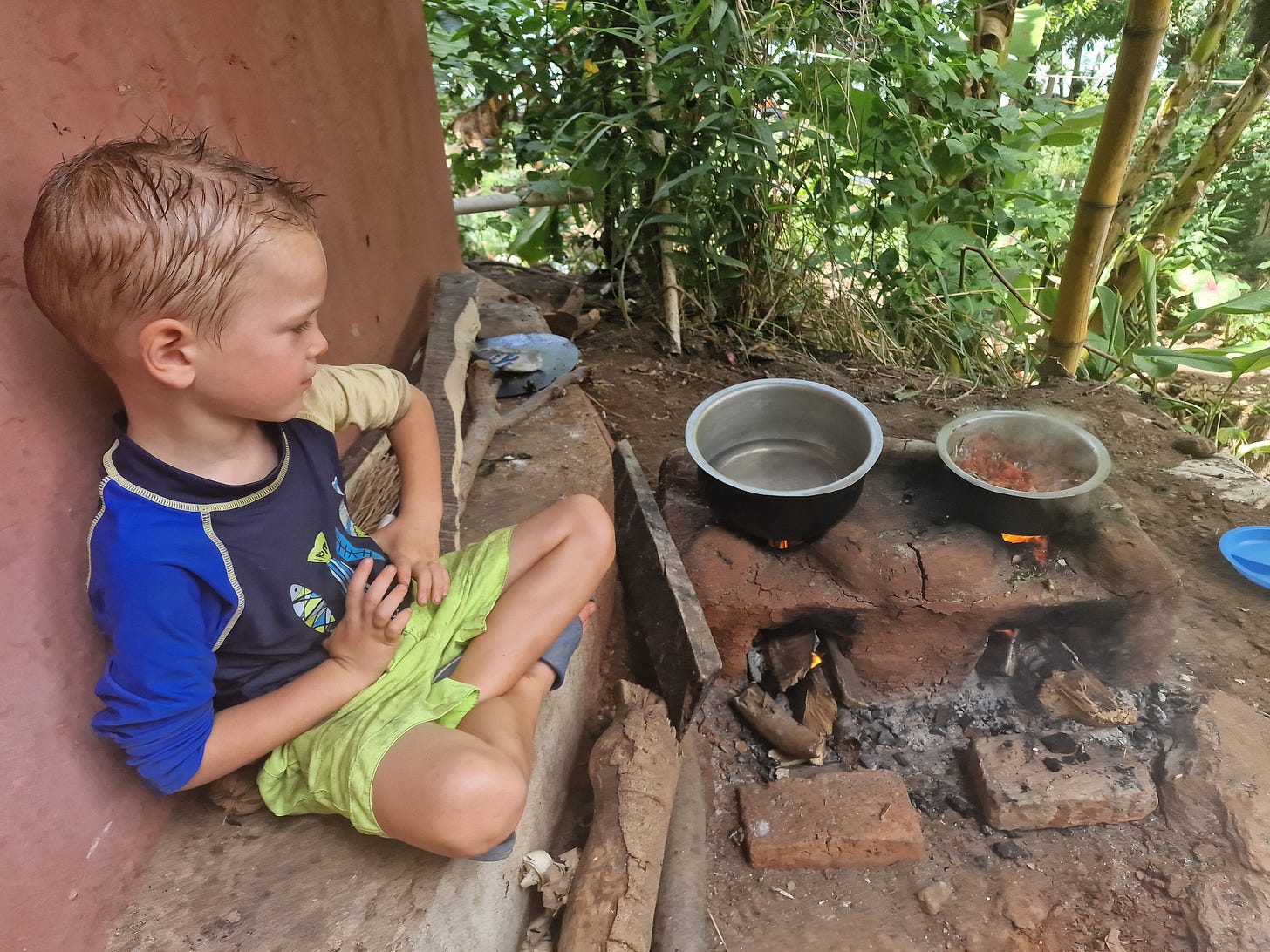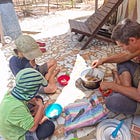Having watched my partner's eyebrows rise almost into his hairline, I knew the Ghanaian chilli fish wasn't going to be easy. What I hadn't expected was to watch (through watering eyes) my hosts’ small children eating it happily.
“They don't mind the spice?” I coughed. I put the bowl down on the palm mat next to my knees. Maybe some of the capsaicin would evaporate?
“Children here eat anything. They are always on the lookout for food,” laughed our host.
“So what is your favourite food?” I asked her daughter (13-year-old Elizabeth, to whom, incidentally, I will be eternally grateful for helping my kids settle into the village school).
Like most teenagers, Elizabeth is incredibly patient with younger children, but has no time for ignorant adults.
“Food”, she said slowly, as if I was a little hard of thinking. Having repeatedly felt very stupid while travelling in traditional cultures, I was not so easily put off.
“The one you like most?” I tried again.
A blank look.
“Like rice?"
“Yes.” The ‘...duh!’ was unspoken, but I heard it.
Last try, Guen, I thought.
“What do you like most with rice?” I asked.
“Soup. Any soup,” she said and returned to hers.
Undeterred, I tried again in other villages. I normally got the same result. Maybe it wasn’t just that I was asking the questions badly - maybe picky eating in older kids just wasn’t a thing.
But children did seem to go through a phase where they were more reluctant to try new foods. Parents on the island of Mafia (Zanzibar's much-less-inhabited neighbour) told me that it was important to give very young children as much food as they will eat whenever they ask, because they will go through a phase where they will refuse to eat normal food. Since other foods are too expensive or distant, the parents don't provide them.
This reluctance phase sounds very familiar to Western parents, but I was surprised to learn that it doesn’t always seem to be a precursor to picky eating (often defined as “unwillingness to eat familiar foods or to try new foods, as well as strong food preferences”). And that apparent Western familiarity extends to the scientific literature: even studies that compare different cultures find similar rates of picky eating. There seems to be a general consensus that picky eating is part of our evolutionary heritage - perhaps because of our sensitivity to smells or perhaps for avoiding poisonous food.
But, there is a massive difference between how the reluctance phase is seen. Parents on Mafia are confident that their children will start eating a normal, varied diet soon after, whereas 30-50% of UK preschoolers don’t. If picky eating was truly universal, as some of the data suggested, then why wasn’t I seeing it in the remote rural communities in which I was living? I kept looking for scientific evidence. Surely some scientist, somewhere, would have described what I was seeing in these communities. It’s much easier to prove that something is not always true than to prove that it is always true. Just one exception is enough.
And that exception is in the data if you dig deep enough - in a 2021 study of eating behaviours in Japanese nursery schools. Children were given a different lunch each day and ate the same food all together. The only exceptions were for children with allergies. Packed lunches were not allowed. Reading through the list of foods provided at lunch in these nursery schools, there was no sign of the ‘kid foods’ so common in my children’s UK nurseries and schools. The results? “We did not witness any problems with picky eaters because picky eating was not tolerated.”
These Japanese nursery schools were worlds away from the villages in which we’d lived, but there were certainly commonalities. In both Japan and in the villages, children had no choice over the food they were given. Humans haven’t evolved to deal with infinite choice, especially not when we’re forming food preferences. Seasonality, scarcity, and avoidance of waste means that historically, children needed to eat what adults eat. Even those children most genetically predisposed to pickiness would train themselves out of it pretty quickly. Practically, picky eating wasn't 'a thing'.
A recent Guardian article, reporting on a study on picky eating, had the headline “Fussy eating in children largely down to genetics, research shows.” And yes, of course there are genetic influences. But that’s true of lots of different scenarios, and a genetic predisposition is not predestination. Bruising your hand if you shut it in the door is genetic too. Some people will bruise less than others. But that doesn’t mean that we shouldn’t bother thinking about how we close the door. Picky eating is the same. Nearly all young mammals are genetically programmed to have a picky stage. But those of us who live in Westernised cultures aren’t careful about growing out of it.
The authors of the Japanese study concluded that, “Other areas of the world including the United States, Europe and other parts of Asia have problems with picky eaters in preschool because parents, teachers and the community expect and tolerate these behaviors. Picky eating appears to be a cultural phenomenon, most common in cultures and communities impacted by Western norms that allow children independence and choice with early feeding decisions.”
This is pretty confusing for parents who’ve ever googled ‘how to get my child to eat more foods’ and found that the advice is usually “give the children independence and choice with early feeding decisions.” Why is this advice so widespread? One of the most recognised studies on baby feeding practises involved babies in an institution who were given a free choice of unprocessed foods and who were reported to consume a balanced diet. This is held up by advocates of baby choice as evidence that babies should be given a lot of choice. But this is an interesting experiment in a bizarre context. Pity the poor hunter-gatherer parent who has to go and seek small quantities of thirty different species each time their offspring feels hunger. Babies have evolved to eat what their parents and community eats, and their transient food suspicion (or food neophobia) is self-correcting when food is variable and limited.

In Westernised countries, we have no such barriers to shield us from the guilt of not giving our hungry toddlers exactly what they're asking for. It's right there! On the shelf! It's not even expensive! It's right there! It's a lot harder for us parents to help children grow out of picky eating.
Children who are genetically predisposed to picky eating only show this tendency in a plentiful environment with Western norms around feeding children. This means that there is hope for all children, no matter their DNA. But we can’t trust our cultural knowledge to help us here. We need to learn from cultures without picky eaters.
What can we do?
Sugar - It’s not a coincidence that the Japanese nurseries in the study served almost nothing sweet. Sweetened beverages were not allowed, dessert was fruit, and holidays and birthdays were celebrated with special not-sweet foods. Children who’ve been introduced to the sweet intensity of sugar are much less likely to want other foods. To be clear, this isn’t about ‘restricting’ sugar intake, it’s about not exposing them to sugar. After the age of two at least, preferably later. And keep it out of nurseries and schools.
Meals - Shift to a one-course (i.e. no separate dessert or starter) habit and offer the exact same foods again in the same ratios if the child is still hungry after eating. Offer different meals - not just the ones that you think the child will eat. The aim is to link hunger with eating, and satiety with stopping, without such distractions as ‘maybe I could get something better’. This is very difficult to achieve in schools where there are different dietary needs, but Japan clearly manages it. If this isn’t enough and you want to know more, check out my upcoming book, Growing up WEIRD.
Modelling - (the parental-behaviour kind, not the fashion kind). You don’t like foods? Don’t let your children find out. Parental picky eating is one of the biggest risk factors for child picky eating. Fake your enthusiasm for lots of different foods, and don’t eat foods in front of your children that you don’t want them to eat.
Snacks - If you're providing snacks to kids, make those snacks do double duty as jaw workouts or microbiome boosters. Whole (or large pieces of) raw veg are the winners here. Don’t waste appetite and motivation on ultraprocessed food.
(nb. Kids older than two or three don't actually need snacks between meals,. They have (excluding some pretty rare diseases) good blood sugar control, and experiencing hunger and learning to handle it is important for adult life. The question really is ‘can nearby adults handle the occasional miniature hanger?’).Treats - Food for special occasions or rewards can be literally anything. The value comes from how they're given. Pick something rare enough that it's not going to show up on the table every week. Fancy olives, possibly? Watermelon?
Cooking - Get kids preparing, and then cooking, their own food ASAP. From age 8-10, cooking for the family once a week and planning the budget for their school lunches is important for life-long food thinking. Policy makers, funding cookery education is important to national health.
Media - A scary percentage of kids’ media (e.g. videos, magazines, school workbooks) glorifies fast food and sugar while offhandedly damning vegetables. It's a mildly funny in-joke if you're an adult. It's honestly damaging if you're a completely naïve child learning what to love and what to hate. Avoid this.
Because healthy eating habits are vital. Just because we’ve forgotten how children’s eating behaviours should self-correct doesn’t mean that they are not important. Our plentiful food environment causes dysregulation of children’s eating behaviours, meaning that picky eating persists. This harms children because it starves their microbiomes (and sometimes even their bodies too), putting them at higher risk of problems with emotional regulation and executive function. And it sets them up for poor eating habits throughout life.
Maybe it’s time to look for inspiration around child feeding practises outside of our Western cultural bubble.
You may also like:
Prefer a podcast?
Notes
Definition of picky eating: https://pubmed.ncbi.nlm.nih.gov/26232139
How common is picky eating? https://www.ncbi.nlm.nih.gov/pmc/articles/PMC5816267
“Picky eating is a normal part of childhood” https://acamh.onlinelibrary.wiley.com/doi/abs/10.1111/jcpp.12530
“Picky eating is genetic” https://acamh.onlinelibrary.wiley.com/doi/10.1111/jcpp.14053
“Children who are sensitive to tastes will become picky eaters” https://www.sciencedirect.com/science/article/abs/pii/S0195666319309869
Cross-cultural similar levels of picky eating: https://www.sciencedirect.com/science/article/abs/pii/S0950329319306068
Guardian article on fussy eating and genetic predisposition: https://www.theguardian.com/food/2024/sep/20/fussy-eating-in-children-largely-down-to-genetics-research-shows
Japanese nursery practises: https://assets-eu.researchsquare.com/files/rs-297653/v1/e902373c-9aec-4fd7-a904-0e24d9e7d39b.pdf?c=1631880005
Picky eating, emotional regulation, and executive function: https://www.mdpi.com/2076-2607/11/9/2245
Picky eating and later eating behaviours: https://www.sciencedirect.com/science/article/pii/S0195666323017427
Effect of parental picky eating on children: https://bmcpediatr.biomedcentral.com/articles/10.1186/s12887-022-03458-0
Picky eating meta-analysis on dietary quality and child weight: https://www.liebertpub.com/doi/abs/10.1089/chi.2023.0196
Media - The BMJ criticised the Beano brand for promoting foods high in salt, fat, and sugar to children. https://www.bmj.com/content/380/bmj.p197 As examples, “There’s an “Ultimate McDonald’s Quiz” (one question is, “How many McDonald’s are there in the world?”), a “How well do you know the Nando’s menu?” quiz, and a “Skittles jokes” page, including this rib tickler: “Why did the leprechaun eat Skittles? Because he wanted to taste the rainbow”—a reference to the advertising slogan of the sweet owned by Mars Wrigley. Another quiz asks children what flavour the brown Hula Hoop crisps are, and there’s an “Ultimate Food Logo” quiz whose 10 answers are: Heinz, Pizza Hut, Nando’s, Subway, Domino’s, KFC, Greggs, Quorn, Pizza Express, and Burger King.”











I was a picky eater as a child. All our food came from boxes or crinkly bags, and we drank soda and sweetened juice all day. We had fresh vegetables maybe two or three times a year. Once I grew up though, I hated being like that. I found it embarrassing. Two things that helped me break that - the first by choice and the second by necessity.
One was deliberately trying new foods regularly, and learning that “new taste or texture” did not mean “going to make me sick”.
And the other was deliberate removal of processed foods and sugar. Occasionally I still have some, and even go a little nuts for a month if I find something I can have, but it’s difficult to do considering that I have food allergies that make it sometimes quite impossible to find even unprocessed foods here in the US.
I’m part of the growing minority here that is allergic to corn, which cuts out most things in grocery store: root vegetables (the corn allergy community figures this is due to absorbed fertilizers from the soil or the corn-based ethanol that makes them sprayable), waxed produce (peppers, pome fruits, cucumbers, citrus fruits, tomatoes, melons), anything with a flow agent (most salt, spice blends, and flour), anything stored on slow-melt ice (brassicas, fish), anything sprayed with or processed with corn-derived acids (meat, most cooking oils), or packaged in a corn-derived plastic.
So now food comes from farmers, the garden, foraging, and occasionally a few fancy expensive brands of pantry goods from fancy expensive stores.
Making food less dopaminergic, harder to get, seasonal, and variable, has cured the pickiness I used to experience, which is the one true silver lining of being allergic to… well, everything.
I was hoping you had a book!
I leaned in hard to baby-led weaning and was so proud that my oldest ate everything. But now she’s suddenly picky at 4, and it’s gutting me. She will simply refuse to eat what we serve and cry during the night that she’s hungry. If a child refuses to eat and seems to be suffering, how long do you go on?